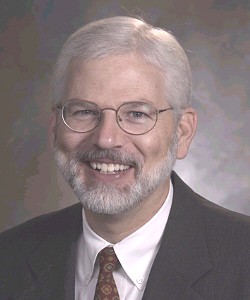Program Information
History Committee Symposium
D Allard1*, G Good2*, M Mueller2*, (1) PA Dept. of Environmental Protection, Elizabethtown, PA, (2) AIP, College Park, MD
Presentations
4:30 PM : William D. Coolidge, Inventor of the Modern X-Ray Tube - D Allard, Presenting Author5:30 PM : Part 1: History and Archives Resources at AIP for AAPM and its Members - G Good, Presenting Author
5:45 PM : Part 2: History and Archives Resources at AIP for AAPM and its Members - M Mueller, Presenting Author
WE-H-204-0 (Wednesday, August 3, 2016) 4:30 PM - 6:00 PM Room: 204
HISTORY COMMITTEE SYMPOSIUM - 2016
Session Organizer: Mr. Michael S. Gossman, M.S., DABR, FAAPM
"William D. Coolidge, Inventor of the Modern X-ray Tube"
Mr. David J. Allard, M.S., CHP
Director, PA DEP Bureau of Radiation Protection
PO Box 8469
Harrisburg, PA 17105-8469
Tel: 717-787-2480
Email: djallard@pa.gov
Email: allradcon@comcast.net
Abstract - William David Coolidge 1873-1975 was a research scientist and inventor of the modern X-ray tube. Besides Roentgen, with his 1895 discovery and subsequent studies of X-rays, perhaps no other individual contributed more to the advancement of X-ray technology than did Coolidge. He was born in Hudson, MA and received his Bachelor of Science degree from MIT in 1896. That same year he went to Europe to study under renowned physicists of the time. Coolidge received his Ph.D. summa cum laude from the University of Leipzig in 1899 and soon after joined the staff of MIT. While studying at Leipzig, he met Roentgen. In 1905 he was asked to join the newly established General Electric Research Laboratory in Schenectady, NY. He promptly began fundamental work on the production of ductile tungsten filaments as a replacement for fragile carbon filaments used in incandescent light bulbs. This improved light bulb was brought to market by GE in 1911. It was subsequent application of his tungsten work that led Coolidge to his studies in X ray production. Circa 1910, the state-of-the-art X-ray tube was a "gas tube" or "cold cathode" type tube. These crude X-ray tubes relied on residual gas molecules as a source of electrons for bombardment of low to medium atomic number metal targets. In 1912 Coolidge described the use of tungsten as an improved anode target material for X-ray tubes. Shortly after in 1913 he published a paper in Physical Review describing “A Powerful Roentgen Ray Tube With a Pure Electron Discharge.” This tube used a tungsten filament as a thermionic source of electrons under high vacuum to bombard a tungsten anode target. Great improvements in X-ray tube stability, output and performance were obtained with the “hot cathode” or “Coolidge tube.” With some variation in filament and target geometry, this 100 year old invention is the same basic X-ray tube used today in medicine, research and industry. In 1932 Coolidge became Director of the GE Laboratory, then in 1940 Vice-President and Director of Research. In 1941 he was a member of a small committee, appointed by President Franklin D. Roosevelt, to evaluate the military importance of research on uranium. This committee’s report led to the establishment of the Manhattan Engineering District for nuclear weapons development during WWII. Coolidge lived to be over 100 years old, he had 83 patents to his credit, numerous awards and honorary degrees, and in 1975 was elected to the National Inventor’s Hall of Fame. At the time he was the only inventor to receive this honor in his lifetime. Dr. Coolidge was also the first recipient of the AAPM’s highest science award - named in his honor. From notes of a day-long interview with Coolidge’s son Lawrence in the mid-1990s, previous biographies, publications, books, GE literature, historic photographs, e.g., a wonderful 1874 photo stereoview card with 1 year old baby “Willie Coolidge”, and other artifacts in the author’s collection, this presentation will review Dr. Coolidge’s amazing life, work, accomplishments and awards.
"History and Archives Resources at AIP for AAPM and its Members"
Mr. Gregory A. Good, Ph.D.
Director, AIP Center for History of Physics
1 Physics Ellipse
College Park, MD 20740
Tel: 301-209-3174
Email: ggood@aip.org
Mrs. Melanie J. Mueller, MLIS
Acting Director, AIP Niels Bohr Library & Archives
1 Physics Ellipse
College Park, MD 20740
Tel: 301-209-3179
Email: mmueller@aip.org
Abstract – The American Institute of Physics established the Center for History of Physics and the Niels Bohr Library & Archives in the 1960s. Our shared mission is: To preserve and make known the history of the physical sciences. This talk will explore the many ways that AIP’s two history programs support the historical and archival activities of AAPM. Topics will include our ongoing oral history program, web outreach through exhibits and teaching guides, and archiving for AAPM and other Member Societies. We will focus in particular on materials in our collections related to the history of medical physics and to the history of AAPM. We will unveil and demonstrate a new “Archives Portal” that we are designing specifically to be useful to AAPM and its members.
Learning Objectives:
1.Study the background of the medical physicist - William David Coolidge
2.Examine the time-line for his success
3.Review the publications conceptualizing his works and progressions
4.Realize what he invented
5.Evaluate the importance of the invention
6.Relate the success to national prominence
7.Uncover how he influenced medical physicists today
8.Find out how he was celebrated by the AAPM
9.View the AIP established Center for History of Physics
10.Consider the significant efforts and vision to preserve the history of medical physics
11.Learn about the Niels Bohr Library & Archives
12.Look back in time at medical physics in the 1960s
13.Unveil and demonstrate a new “Archives Portal” that will be useful to AAPM
Handouts
- 115-31564-385514-119251.pdf (D Allard)
- 115-31565-385514-119252.pdf (G Good)
Contact Email:





